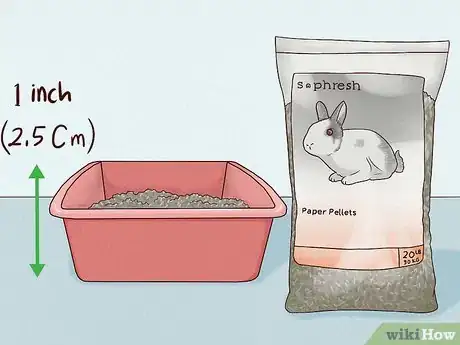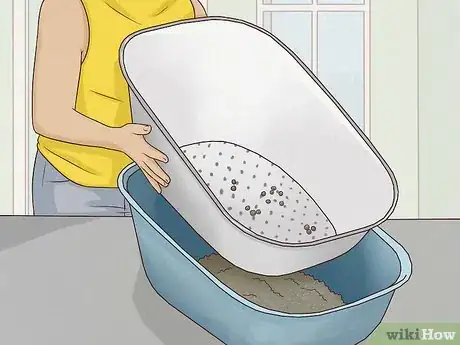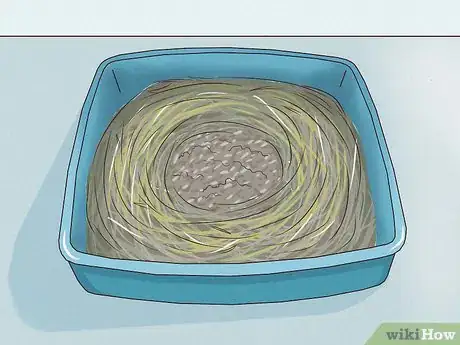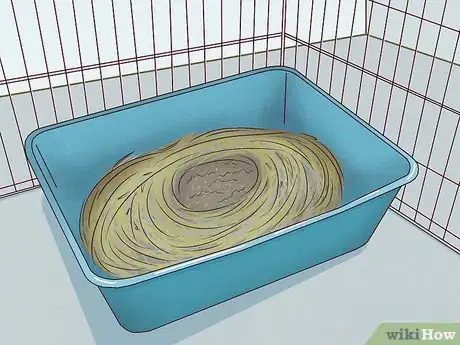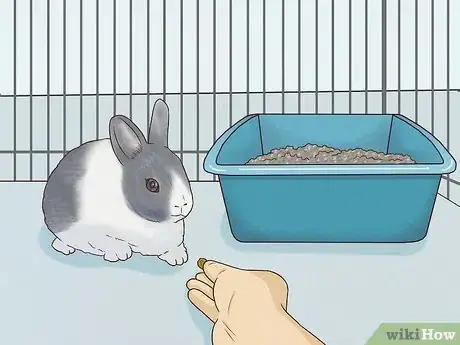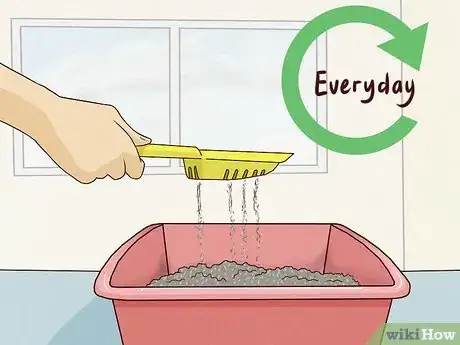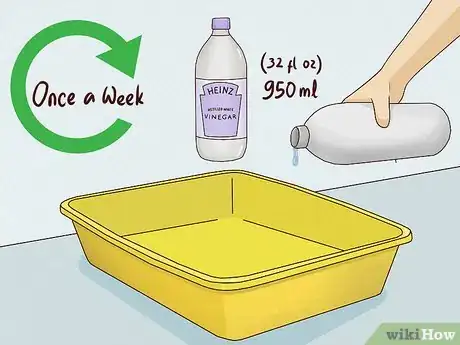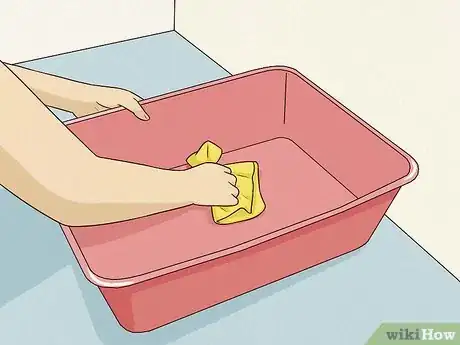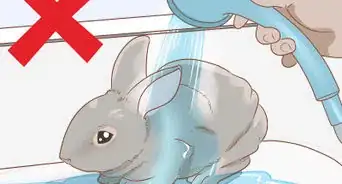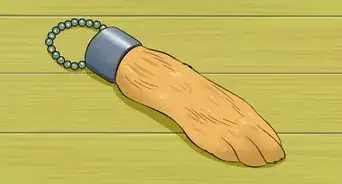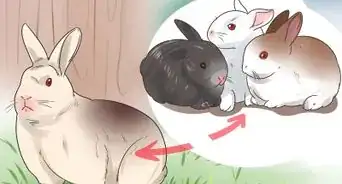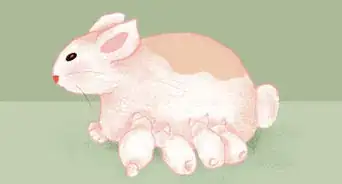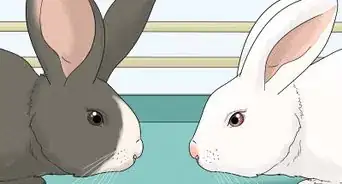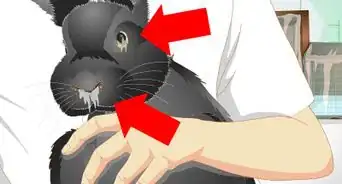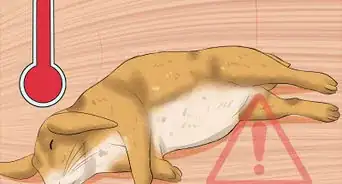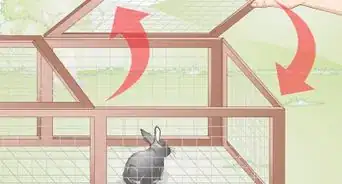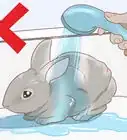wikiHow is a “wiki,” similar to Wikipedia, which means that many of our articles are co-written by multiple authors. To create this article, volunteer authors worked to edit and improve it over time.
There are 7 references cited in this article, which can be found at the bottom of the page.
This article has been viewed 13,822 times.
Learn more...
Bunnies can be litterbox trained as easily as cats. However, you need a slightly different litterbox setup for a bunny than a cat. This includes using a special type of box and litter. You will also need to entice your bunny to use the box with hay and other treats. Once your bunny is using the box regularly, keep the box clean to ensure that your bunny will continue this good behavior!
Steps
Setting up the Litterbox
-
1Choose a standard litterbox that is low enough for your rabbit to enter. Opt for a large-sized pan so your rabbit will have plenty of space to do its business. However, if you have a pair of rabbits or a rabbit that weighs over 10 lb (4.5 kg), then get a giant-sized litterbox.[1] You can go with a pan that is the same height all the way around, or choose a box that has 1 low side to make it easier for your rabbit to get into the box.[2]
- Standard height litter pans and high back litter pans are good choices for most rabbits.
- If the litterbox is too high for your bunny to get into, use a sharp pair of scissors to cut out a 12 by 4 in (30 by 10 cm) section on 1 side of the litterbox. This will make it easier for your bunny to get in and out of the litterbox with ease.[3]
-
2Fill the litterbox with a 1 in (2.5 cm) layer of newspaper pellet litter. This type of litter will not pose a hazard to your bunny’s health. You can find this type of litter in pet and grocery stores.[4]
- Avoid clay, pine, and cedar litters as the fumes and dust from these kinds of litter are hazardous to your bunny.[5]
- If you cannot find newspaper pellet litter, then you can also use pellet stove wood as litter for your bunny’s box. However, make sure it does not contain any accelerants.
Advertisement -
3Place a plastic grate over the litter to prevent scattered litter pellets. If your rabbit is prone to digging and scattering its litter when it uses its box, placing a plastic tray over the litter can help to prevent this. You can purchase special litter boxes that come with a plastic sifting tray, or cut a plastic mushroom crate to fit the box.[6]
- Ask for a used mushroom crate at your local grocery store. Be sure to rinse the crate to remove any dirt and debris before you use it. Then, use a sharp pair of scissors to cut the crate to the size of your litterbox.
-
4Cover the litter with hay up to the top of the litterbox. Rabbits like to munch on hay while they use the litterbox and they will often hang out in the litterbox as well. Place enough hay over the litter to completely cover it and fill the box up to the rim.[7]
- Use quality hay, such as Timothy hay so that you rabbit will want to eat it.
Tip: Don’t worry about your rabbit getting sick from eating dirty hay. It will establish a clean corner of the box that it munches from, and do its business in the other corner.[8]
Teaching Your Rabbit to Use the Box
-
1Place the litterbox in the corner of your rabbit’s enclosure. Your rabbit needs to have constant access to the box, and it should take up a significant section of its enclosure. Place the litterbox in 1 side or corner of your bunny’s enclosure. Your rabbit will inspect it and establish a corner where it will do its business.[9]
- If you let your bunny roam outside of its enclosure, place the litterbox in a corner of the room. Place your bunny in the box to show it where it is located.
-
2Use positive reinforcement to encourage your bunny to use the box. You can reward your rabbit with a treat, such as a single raisin. Offer a raisin when the rabbit goes near the box at first, and then after a few days of this, only give a raisin whenever it does its business in the box. After a few weeks, you won’t need to reward your bunny with treats at all because the behavior will become a habit.
- Also, make sure to offer lots of praise and petting when your bunny uses the litterbox!
- Never yell, hit, or otherwise punish your rabbit for going to the bathroom outside of its box! This will only frighten the rabbit.
-
3Clean up messes with an enzymatic cleanser. It is important to pick up feces and clean up any urine outside of the litterbox right away. This will help to discourage the rabbit from going in the same spot again. Spray an enzymatic cleanser meant for cleaning up pet messes directly onto the urine. Then, dab the spot with clean paper towels to soak up the mess.[10]
- You can purchase an enzymatic cleanser in a pet supply store.
-
4Set up a second box if your bunny uses more than 1 spot. If your bunny has multiple spots that it likes to go potty when it is roaming outside of its enclosure, then you may need to set up 1 or more extra boxes. Place these boxes in the spots your bunny likes to go.[11]
- For example, if your bunny goes to the bathroom in 2 corners of your living room, then place 1 box in each corner.
Tip: If you have more than 1 bunny, you will definitely need more than 1 litterbox when they are out of their enclosure! Try getting 1 more litterbox than the total number of bunnies you have, such as 3 boxes if you have 2 bunnies.
Keeping the Box Clean
-
1Dump the entire contents of the box daily to clean it. Your rabbit will fill its box up quickly, so it is important to keep it clean. Otherwise, it might not want to use the box. To clean the rabbit’s box, simply dump out the contents and replenish the box with new litter and hay.[12]
- You can dump the litterbox contents into the garbage, or dump them into your yard or garden to use as a natural fertilizer.
Warning: Never go more than 2 days without changing your bunny’s litterbox! It will start to smell and your bunny will also be less likely to use it while it is dirty.
-
2Soak the inside of the empty box with plain white vinegar weekly. A weekly vinegar soak will help to prevent bacteria from building up in the litter box and keep it smelling fresh. Pour 32 fl oz (950 mL) of white vinegar into the box, and tilt the box back and forth a few times to get the vinegar on all sides. Then, wait about 15 minutes, and pour out the vinegar. Follow up by rinsing the box with water.[13]
- Do this outside so you can pour the vinegar onto the ground.
-
3Wipe the box with a clean paper towel before adding fresh litter and hay. After you have cleaned the inside of your box, dry it thoroughly with a clean paper towel. Then, replenish the box with a clean layer of litter and hay.[14]
- Never reuse the same litter or hay in your rabbit’s litter box!
Things You’ll Need
- Standard height or high-back cat litter pan
- Scissors
- Newspaper pellet litter or wood stove pellets
- Litter pan sifting tray or mushroom tray
- Timothy hay
- Raisins
- Enzymatic cleanser
- Paper towels
- White vinegar
References
- ↑ https://www.animalhumanesociety.org/behavior/bunnys-litter-box
- ↑ https://www.ohiohouserabbitrescue.org/litterbox/
- ↑ https://www.youtube.com/watch?v=mRu3CNee-94&feature=youtu.be&t=97
- ↑ https://www.ohiohouserabbitrescue.org/litterbox/
- ↑ https://www.sandiegorabbits.org/lb.php
- ↑ https://www.youtube.com/watch?v=1MSI3DJqoF4&feature=youtu.be&t=11
- ↑ https://www.ohiohouserabbitrescue.org/litterbox/
- ↑ https://www.sandiegorabbits.org/lb.php
- ↑ https://www.ohiohouserabbitrescue.org/litterbox/
- ↑ https://www.soquelvet.com/storage/app/media/LitterBoxTrainingRabbits-x.pdf
- ↑ https://www.soquelvet.com/storage/app/media/LitterBoxTrainingRabbits-x.pdf
- ↑ https://www.animalhumanesociety.org/behavior/bunnys-litter-box
- ↑ https://www.sandiegorabbits.org/lb.php
- ↑ https://www.sandiegorabbits.org/lb.php

